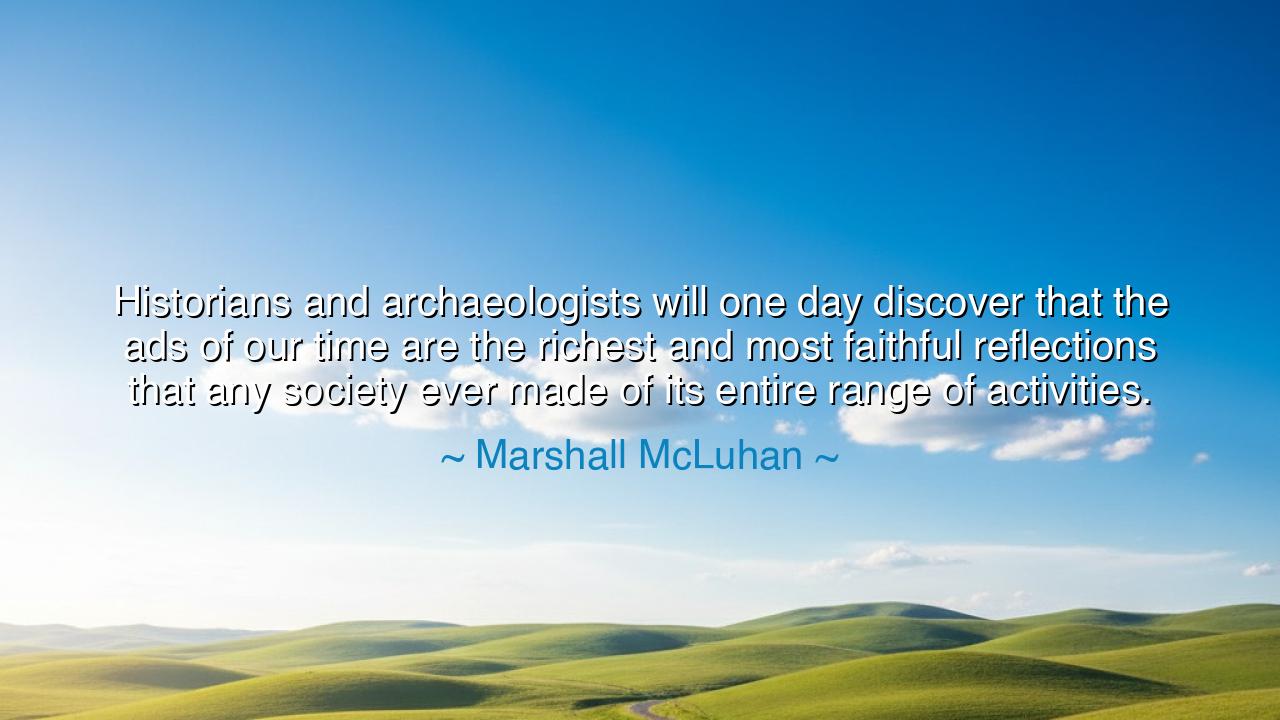
Historians and archaeologists will one day discover that the ads
Historians and archaeologists will one day discover that the ads of our time are the richest and most faithful reflections that any society ever made of its entire range of activities.






"Historians and archaeologists will one day discover that the ads of our time are the richest and most faithful reflections that any society ever made of its entire range of activities." These words, spoken by the visionary Marshall McLuhan, hold a profound truth that speaks to the nature of human expression and the ways in which societies communicate and define themselves. In the distant future, as historians and archaeologists sift through the relics of our time, they may not find the monuments or the wars that we imagine will define us, but instead, they may turn to the ads—those ubiquitous messages that have permeated every corner of our modern world—as the truest reflection of our age.
The advertisement, in its simplest form, is not just a tool to sell goods; it is a mirror to the society that creates it. Every color, every word, every image in an ad is a message that speaks to the values, the desires, and the fears of the people who live under the shadow of that society. McLuhan understood this better than most—he saw that advertisements were not mere commercial tools, but deeply embedded cultural expressions. They reflect, in striking clarity, what society holds dear, what it fears, what it wishes for, and what it deems important. They are not simply images of commerce; they are the visual language of a culture, a culture that is constantly evolving, constantly reaching for new dreams and new identities.
In the ancient world, sculpture, temple art, and written texts were the ways in which societies recorded their values and beliefs. The Greeks, for example, built their grand temples to honor their gods, and their stories—told through vases, statues, and poetry—revealed their understanding of virtue, strength, and beauty. The ancient Egyptians too, with their majestic pyramids and intricately painted tombs, sought to communicate the spiritual aspirations of their civilization, a desire for immortality and the triumph of their rulers. These physical objects were not just art; they were the mirror to the soul of the civilization, a way of communicating with future generations.
In the same way, modern advertisements are our civilization's method of communicating with the future. What do the products we promote tell the world about us? What do they say about our values, our insecurities, our aspirations? The advertisements for cars, perfumes, or technology are not just selling products; they are selling lifestyles—the promise of a better, more fulfilled life. Take, for example, the iconic Coca-Cola advertisement, where a group of people joyously gather, sharing in the universal bond of refreshment. This image is not simply a plea to purchase a drink—it is a representation of the ideals of community, happiness, and togetherness that our society holds dear. It speaks of a world where simple pleasures are cherished and shared, and where personal connection is valued above all.
Consider also the advertisements of the past, from the early days of the industrial revolution, when products were sold as a means of bringing modernity and efficiency to life. The posters and print ads from that time tell us not just about the products themselves, but about the societal changes underway. The industrial age was a time of rapid change, when the promise of progress was everywhere. The imagery of machines, the appeal to work and productivity, speaks volumes about the values of the time—efficiency, progress, and the triumph of human ingenuity over nature. These ads, though simple, are windows into the very soul of an age, capturing a moment in time when capitalism and industry reshaped the world.
McLuhan’s foresight reminds us that advertisements are not mere commercial expressions, but cultural artifacts. They are, in a sense, a language of their own, a symbolic language that encodes the aspirations, fears, and dreams of an entire civilization. Just as the statues of the gods or the philosophical texts of the ancients gave us insight into the values of those societies, so too do our modern ads reveal the values of our own time. They are the echoes of our desires, our frustrations, and our search for meaning. In these seemingly simple messages, we see the reflection of a culture that is both optimistic and anxious, a culture that seeks to escape while simultaneously desiring to be more, to be better.
The lesson we can take from McLuhan’s words is this: do not overlook the small things. In a world that is so focused on grand gestures—on monuments, wars, and politics—sometimes it is the mundane elements of society, like advertisements, that reveal the most about who we are. They speak to the soul of a civilization in a way that few other forms of expression can. They capture the desires of the people, the shifting dynamics of power, and the unspoken anxieties of an era. As we move forward, let us pay attention not only to the monuments and wars of our time, but to the advertisements that shape our perceptions of reality, for they are the true mirror of our civilization. In this, we will begin to understand not only our present, but also the legacy we will leave behind. Let us make sure that the messages we send, even in the form of ads, are worth remembering.






AAdministratorAdministrator
Welcome, honored guests. Please leave a comment, we will respond soon